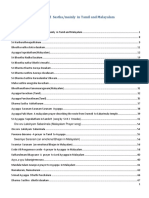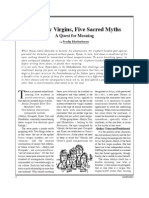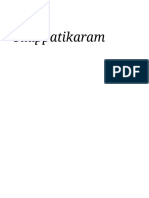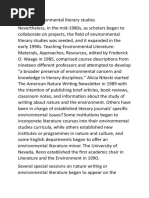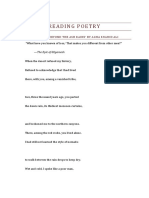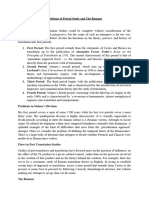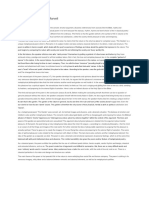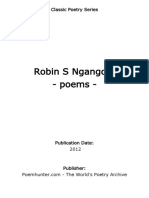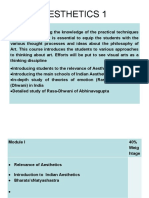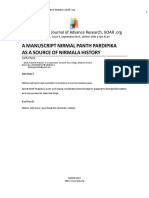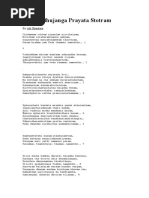0 ratings0% found this document useful (0 votes)
286 viewsSchool of Indian Aesthetics) Which Was Later Elaborately: ND ND
School of Indian Aesthetics) Which Was Later Elaborately: ND ND
Uploaded by
Chandan KumarThe Natyashastra is an ancient Sanskrit text from either the 2nd century BCE or 2nd century CE that is attributed to Bharata Muni. It is the earliest surviving text on dramaturgy and histrionics in the world. The vast treatise covers all aspects of Indian classical dance, music, and drama. It established the foundation of Indian aesthetic theory, particularly the concept of Rasa, or aesthetic experience. The Natyashastra had a remarkable influence on the growth and development of fine arts in India by laying out the principles of dramaturgy, performance, and aesthetics.
Copyright:
© All Rights Reserved
Available Formats
Download as DOC, PDF, TXT or read online from Scribd
School of Indian Aesthetics) Which Was Later Elaborately: ND ND
School of Indian Aesthetics) Which Was Later Elaborately: ND ND
Uploaded by
Chandan Kumar0 ratings0% found this document useful (0 votes)
286 views5 pagesThe Natyashastra is an ancient Sanskrit text from either the 2nd century BCE or 2nd century CE that is attributed to Bharata Muni. It is the earliest surviving text on dramaturgy and histrionics in the world. The vast treatise covers all aspects of Indian classical dance, music, and drama. It established the foundation of Indian aesthetic theory, particularly the concept of Rasa, or aesthetic experience. The Natyashastra had a remarkable influence on the growth and development of fine arts in India by laying out the principles of dramaturgy, performance, and aesthetics.
Original Description:
Natyashastra
Original Title
Natyashastra
Copyright
© © All Rights Reserved
Available Formats
DOC, PDF, TXT or read online from Scribd
Share this document
Did you find this document useful?
Is this content inappropriate?
The Natyashastra is an ancient Sanskrit text from either the 2nd century BCE or 2nd century CE that is attributed to Bharata Muni. It is the earliest surviving text on dramaturgy and histrionics in the world. The vast treatise covers all aspects of Indian classical dance, music, and drama. It established the foundation of Indian aesthetic theory, particularly the concept of Rasa, or aesthetic experience. The Natyashastra had a remarkable influence on the growth and development of fine arts in India by laying out the principles of dramaturgy, performance, and aesthetics.
Copyright:
© All Rights Reserved
Available Formats
Download as DOC, PDF, TXT or read online from Scribd
Download as doc, pdf, or txt
0 ratings0% found this document useful (0 votes)
286 views5 pagesSchool of Indian Aesthetics) Which Was Later Elaborately: ND ND
School of Indian Aesthetics) Which Was Later Elaborately: ND ND
Uploaded by
Chandan KumarThe Natyashastra is an ancient Sanskrit text from either the 2nd century BCE or 2nd century CE that is attributed to Bharata Muni. It is the earliest surviving text on dramaturgy and histrionics in the world. The vast treatise covers all aspects of Indian classical dance, music, and drama. It established the foundation of Indian aesthetic theory, particularly the concept of Rasa, or aesthetic experience. The Natyashastra had a remarkable influence on the growth and development of fine arts in India by laying out the principles of dramaturgy, performance, and aesthetics.
Copyright:
© All Rights Reserved
Available Formats
Download as DOC, PDF, TXT or read online from Scribd
Download as doc, pdf, or txt
You are on page 1of 5
Natyashastra
Attributed to Bharata Muni
(2nd BCE to 2nd CE)
• The foundation of the Indian aesthetic theory can
be traced to Bharatamuni’s Natyashastra in which he
gives his theory of theory of Rasa(1st school of
Indian Aesthetics) which was later elaborately
developed by learned scholars.
• Natyashastra is the most detailed and elaborate
of all treatises on dramatic criticism and acting ever
written in any language and is regarded as the oldest
surviving text on stagecraft in the world. (2nd BCE to
2nd CE)
• Bharata muni in his Natyashastra demonstrates
every aspect of Indian drama , covering areas like
music, stage-design, make up, dance and virtually
every aspect of stagecraft.
• With its wider scope Natyashastra has offered a
remarkable dimension to growth and development of
Indian classical music, dance, drama and art. Hence it
is certainly not an overstatement to say that
Natyashastra indeed laid the cornerstone of the fine
arts in India. The commentaries on the Natyashastra
are known, dating from the sixth or seventh centuries.
• However Abhinavabharati (10th -11th CE) is
regarded as the most authoritative commentary on
Natyashastra as Abhinavagupta provides not only his
own illuminating interpretation of the Natyashastra,
but wide information about pre-Bharata traditions as
well as varied interpretations of the text offered by
his predecessors
• Written in Sanskrit, the vast treatise consists
6,000 sutras. The Natyashastra has been divided into
36 chapters, sometimes into 37 or 38 due to further
bifurcation of a chapter or chapters. The title can be
loosely translated as "A compendium of Theatre or a
A Manual of Dramatic Arts".
• Natyashastra consists of four elements namely
• pathya or text, including the art of recitation and
rendition in performance taken from the Rig Veda.
• The other one is gita or songs, including
instrumental music from the Sama Veda,
• abhinaya or acting, the technique of expressing
the poetic meaning of the text and communicating it
to the spectator from the Yajur Veda, and
• rasa or aesthetic experience from the Atharva
Veda.
• it is the anukirtana of bhava i.e `re-telling` of
emotive states in order to create a new world of
`imagination`.
• The background of Natyashastra is framed in a
situation where a number of munis approach Bharata
to know about the secrets of Natyaveda. The answer
to this question comprises the rest of the book. Quite
ideally therefore narratives, symbols and dialogues
are used in the methodology of Natyashastra.
• Natyashastra opens with the origin of theatre,
beginning with inquiries made by Bharata`s pupils,
which he answers by narrating the myth of its source
in Brahma. He also explains the very nature,
objective, and expanse of natya as a Veda through
this unique myth
• Brahama states, "Hence I have devised the
drama in which meet all the departments of
knowledge, different arts and various actions..."
• Bharata clearly states,
• Na ta gyaana na ta shilpa na sa vidya na sa
kala/
Na sa yogo na tat karma yan natyesmin na
drsyate // NS 1.116.
[There is no wise maxim, no learning, no art or craft,
no device,
no action that is not found/reflected in the drama.]
• In the history of Indián aesthetic thought, the
concept of rasa
is the oldest since Bharata himself gives in his
Natyasastra some cita-
tions from earlier works which already refer to rasa.
His greatness lay
in giving it a vítal and centrál place in his scheme of
tenfold plays and
explaining it in terms of vibhava, anubhava and
yyabhicaribhnva schemati-
cally.
• It appears that all the elements in a play, námely
plot, characterisation, style, setting and acting are
governed by the dictates of rasa.
• His famous rasa-sutra led to diverse explanations
at the hands of láte
philosophers, the chief of whom are Bhatta Lollata,
Sankuka, Bhatta Nayaka
and Abhinavagupta.
• The Other Four Schools of Indian Aesthetics
Dhwani School – Theory of Meaning
Alamkara School-
• Bahamana and the Alamkara Shastra
• Pure art of Poetics
• Stress on ornamentation of form
• Poetic Excess
• Riti
Vamana and Riti
Riti as the soul of Kavya
– Vaidharbi
– Panchali
– Gaudi
Auchitya
• Kshemendra and Auchitya School of Thought
• Inner harmony of a work of art
• Rule based aesthetics
• Inner formalism
You might also like
- Aqa Gcse History Elizabethan EmglandDocument20 pagesAqa Gcse History Elizabethan EmglandBivvyNo ratings yet
- Stotras Addressed To Lord Sasthamainly in Tamil and MalayalamDocument451 pagesStotras Addressed To Lord Sasthamainly in Tamil and MalayalamKCTV NEWS PUNGANUR50% (2)
- Church ManagementDocument12 pagesChurch ManagementtewoldemNo ratings yet
- Five Holy Virgins - Pradip BhattacharyaDocument43 pagesFive Holy Virgins - Pradip Bhattacharyameenaldutia100% (4)
- Establishment of MindfulnessDocument5 pagesEstablishment of MindfulnessMario Galle MNo ratings yet
- Nat Ya ShastraDocument15 pagesNat Ya ShastraJasdeep SinghNo ratings yet
- BEGC-101: Indian Classical LiteratureDocument48 pagesBEGC-101: Indian Classical LiteratureSammyNo ratings yet
- The Main Aspects of Indian Aesthetics - MDocument10 pagesThe Main Aspects of Indian Aesthetics - MJaisree KhavisharanNo ratings yet
- AssignmentDocument9 pagesAssignmentaparnaNo ratings yet
- Riti - Class NotesDocument2 pagesRiti - Class NotesKamal Jajoriya0% (1)
- Language of Paradox As Language of PoetryDocument2 pagesLanguage of Paradox As Language of PoetrySauhardya RitNo ratings yet
- Cilappatikaram - WikiDocument55 pagesCilappatikaram - WikiDaliya. XNo ratings yet
- Modern Poetic Trends of Odisha Versus The Neoteric Strives of GuruprasadDocument21 pagesModern Poetic Trends of Odisha Versus The Neoteric Strives of GuruprasadEditor IJTSRDNo ratings yet
- Derozio 1Document15 pagesDerozio 1LuminaNo ratings yet
- 06 - Chapter 3Document60 pages06 - Chapter 3funny videosNo ratings yet
- Splendid - Contribution of - Toru - Dutt - in - IndiaDocument4 pagesSplendid - Contribution of - Toru - Dutt - in - Indiakrishnanjali4202No ratings yet
- Rasa Dhvani AuchityaDocument9 pagesRasa Dhvani AuchityaKamal JajoriyaNo ratings yet
- Wife Into Husband - Premchand PDFDocument8 pagesWife Into Husband - Premchand PDFDelcy AmalNo ratings yet
- What's The Use of Theorizing About The Arts - 1Document16 pagesWhat's The Use of Theorizing About The Arts - 1JoemNo ratings yet
- Snow On The Desert NotesDocument4 pagesSnow On The Desert NotesSrihithaNo ratings yet
- Sanskrit Non Translatables PreviewDocument29 pagesSanskrit Non Translatables PreviewrajeshkumarmaityNo ratings yet
- The Theory of AlamkaraDocument5 pagesThe Theory of Alamkarashilajit biswasNo ratings yet
- Crisis of National Identity in Agha ShahDocument6 pagesCrisis of National Identity in Agha ShahKhalil AbdulhameedNo ratings yet
- The Curse Motif in AbhijnanashakuntalamDocument15 pagesThe Curse Motif in AbhijnanashakuntalamRao Sombir yadavNo ratings yet
- Birth of Environmental Literary StudiesDocument3 pagesBirth of Environmental Literary Studiesexam purposeNo ratings yet
- The Voice - Thomas HardyDocument3 pagesThe Voice - Thomas HardyDánisaGarderesNo ratings yet
- Sad Strains of A Gay WaltzDocument4 pagesSad Strains of A Gay WaltzmindlessarienNo ratings yet
- CharulataDocument2 pagesCharulatamisanthropistNo ratings yet
- The Beginnings of American LiteratureDocument8 pagesThe Beginnings of American LiteratureLucanezulNo ratings yet
- Indian Classical LiteratureDocument8 pagesIndian Classical LiteratureAiman AliNo ratings yet
- Reading Poetry: Lesson 21: Beyond The Ash Rains' by Agha Shahid AliDocument7 pagesReading Poetry: Lesson 21: Beyond The Ash Rains' by Agha Shahid AliJaya DasNo ratings yet
- Types of Intellectuals in Antonio Gramsci's The Formation of The IntellectualsDocument3 pagesTypes of Intellectuals in Antonio Gramsci's The Formation of The IntellectualsNasim AkhterNo ratings yet
- Toba Tek Singh Line by Line ExplanationDocument6 pagesToba Tek Singh Line by Line Explanationsomiyamandal20No ratings yet
- Halfway HouseDocument4 pagesHalfway Houseपुष्प समब्याल100% (1)
- Transformation of Rani and Her Emerging IdentityDocument9 pagesTransformation of Rani and Her Emerging IdentitySneha PradhanNo ratings yet
- Savitri Book 1 Canto 1 Post 5Document3 pagesSavitri Book 1 Canto 1 Post 5api-3740764No ratings yet
- Problems of Period Study and The RomansDocument3 pagesProblems of Period Study and The RomansYasir BukhariNo ratings yet
- Aesthetics, Gender, and Canon in Anti-Caste Graphic Narratives, A Gardener in The Wasteland and BhimayanaDocument18 pagesAesthetics, Gender, and Canon in Anti-Caste Graphic Narratives, A Gardener in The Wasteland and BhimayanaJoyashree DeyNo ratings yet
- Poet, Lover, BirdwatcherDocument13 pagesPoet, Lover, BirdwatcherFhjjhhvNo ratings yet
- Hayavadana by Girish Karnad: R. SharmilaDocument4 pagesHayavadana by Girish Karnad: R. SharmilaRishav RajNo ratings yet
- Translations of MahabharataDocument3 pagesTranslations of Mahabharatamervy83No ratings yet
- History of Indo Anglian PoetryDocument116 pagesHistory of Indo Anglian PoetrymaayeraNo ratings yet
- Cracking India Tells The Story of The Partition ofDocument7 pagesCracking India Tells The Story of The Partition ofmarviNo ratings yet
- A Poem For My MotherDocument3 pagesA Poem For My Motherxoh23028No ratings yet
- Acculturation and Diasporic Influence in Uma Parmeswaran's "What Was Always Hers" - Anju MeharaDocument4 pagesAcculturation and Diasporic Influence in Uma Parmeswaran's "What Was Always Hers" - Anju MeharaProfessor.Krishan Bir Singh100% (1)
- 06 Chapter4Document15 pages06 Chapter4Surajit MondalNo ratings yet
- 10 Chapter 4Document30 pages10 Chapter 4Avinaba BhattacharjeeNo ratings yet
- The Garden - Andrew MarvellDocument1 pageThe Garden - Andrew MarvellSouvik BiswasNo ratings yet
- Prospero Caliban Cricket - BreadDocument22 pagesProspero Caliban Cricket - Breadserin princeNo ratings yet
- Autobiography of Binodini DasiDocument5 pagesAutobiography of Binodini DasiBarsha D.No ratings yet
- Translation As RecoveryDocument5 pagesTranslation As RecoveryAAryan NayakNo ratings yet
- TH THDocument7 pagesTH THReshmaNo ratings yet
- Introduction: My Grandmother's House Is A Poem Written by Indian Poet KamalaDocument7 pagesIntroduction: My Grandmother's House Is A Poem Written by Indian Poet Kamalavishakha.22bap903100% (1)
- Perspectives On Thematic Concerns in Girish Karnad's Yayati PDFDocument8 pagesPerspectives On Thematic Concerns in Girish Karnad's Yayati PDFDEEPALI SETHNo ratings yet
- Ashapurna Devi Final PaperDocument14 pagesAshapurna Devi Final PapericeagNo ratings yet
- As A RefutationDocument2 pagesAs A RefutationSaleem Raza100% (1)
- The Dalit Theatre (Rangbhoomi) in MaharashtraDocument5 pagesThe Dalit Theatre (Rangbhoomi) in Maharashtraharesh1883No ratings yet
- Robin S Ngangom 2012 6 PDFDocument26 pagesRobin S Ngangom 2012 6 PDFNarges KazemiNo ratings yet
- Presentation - HangwomanDocument49 pagesPresentation - Hangwomanserin princeNo ratings yet
- Theatricality in Andha YugDocument2 pagesTheatricality in Andha YugAtharva DeshmukhNo ratings yet
- Train To Pakistan PresentationDocument104 pagesTrain To Pakistan PresentationCol Dr Akhtar Ahmed KhaliliNo ratings yet
- Ode On The Death of MR Thomson ExplanationDocument7 pagesOde On The Death of MR Thomson Explanationfourthhorseman92No ratings yet
- A STUDY OF TEMSULA AO'S These Hills Called Home - Copy2Document4 pagesA STUDY OF TEMSULA AO'S These Hills Called Home - Copy2abhijit8sarkar-3No ratings yet
- The Indian Emperor: "Boldness is a mask for fear, however great."From EverandThe Indian Emperor: "Boldness is a mask for fear, however great."No ratings yet
- Japanese AnimationDocument11 pagesJapanese AnimationChandan KumarNo ratings yet
- History of Anime & MangaDocument8 pagesHistory of Anime & MangaChandan KumarNo ratings yet
- Definition of PersonalityDocument13 pagesDefinition of PersonalityChandan KumarNo ratings yet
- Gaming HistoryDocument32 pagesGaming HistoryChandan KumarNo ratings yet
- Chinese AnimationDocument15 pagesChinese AnimationChandan KumarNo ratings yet
- Cover LettersDocument9 pagesCover LettersChandan KumarNo ratings yet
- Victorian EraDocument4 pagesVictorian EraChandan KumarNo ratings yet
- Sample Resume: Douglas G. DaleDocument2 pagesSample Resume: Douglas G. DaleChandan KumarNo ratings yet
- The Western Gaze in Animation: A Case Study Of: Chenjun WangDocument10 pagesThe Western Gaze in Animation: A Case Study Of: Chenjun WangHenry WaribuhNo ratings yet
- Romanesque ArtDocument23 pagesRomanesque ArtChandan KumarNo ratings yet
- Rasa Theory: Aesthetics of EmotionDocument11 pagesRasa Theory: Aesthetics of EmotionChandan KumarNo ratings yet
- Human Rights, Values and EthicsDocument4 pagesHuman Rights, Values and EthicsChandan KumarNo ratings yet
- English Business LetterDocument3 pagesEnglish Business LetterChandan KumarNo ratings yet
- What Is AestheticsDocument9 pagesWhat Is AestheticsChandan KumarNo ratings yet
- 2016 French Sem. 1 Notes PDFDocument32 pages2016 French Sem. 1 Notes PDFChandan Kumar0% (1)
- A Turning Point: 1998: Dreamworks SKG Era (1994-2006)Document2 pagesA Turning Point: 1998: Dreamworks SKG Era (1994-2006)Chandan KumarNo ratings yet
- Ancient Chinese Painting On Contemporary ArtDocument73 pagesAncient Chinese Painting On Contemporary ArtChandan KumarNo ratings yet
- Cartooning The Ultimate Character Design Book PDFDocument17 pagesCartooning The Ultimate Character Design Book PDFChandan KumarNo ratings yet
- Basics of Medical AstrologyDocument19 pagesBasics of Medical AstrologyRishu Sanam Garg50% (2)
- LAE Vocabulary Flash Cards 300 - 433Document79 pagesLAE Vocabulary Flash Cards 300 - 433MaanParrenoVillar100% (3)
- PrivatebaramullaDocument10 pagesPrivatebaramullaMhdbaqirNo ratings yet
- Shirin Neshat DiscussionDocument4 pagesShirin Neshat Discussionwolfa3524No ratings yet
- L16 (Planting Plan, BOQ & Schedule of Plants - Stage 1 - Trees) Sheet 2 of 2Document1 pageL16 (Planting Plan, BOQ & Schedule of Plants - Stage 1 - Trees) Sheet 2 of 2khan17141588No ratings yet
- PongalDocument4 pagesPongalAdalberto MacdonaldNo ratings yet
- God and Man. ENGDocument12 pagesGod and Man. ENGvancung lyanNo ratings yet
- Reviewer PrelimDocument6 pagesReviewer PrelimTabios EricaNo ratings yet
- Journal Islamic Medicine History and Current PracticeDocument19 pagesJournal Islamic Medicine History and Current Practicefarrel2689No ratings yet
- 2018 - Summer 1 SyllabusDocument3 pages2018 - Summer 1 SyllabusEquipping CoursesNo ratings yet
- Wake Up, O Sleeper!Document4 pagesWake Up, O Sleeper!Mathew VillarNo ratings yet
- Hindu Today April 2014Document52 pagesHindu Today April 2014Antonieta SHNo ratings yet
- The Karmic Numbers:: Ankakshr Miracless अंकाक्षर मिरेकल्सDocument3 pagesThe Karmic Numbers:: Ankakshr Miracless अंकाक्षर मिरेकल्सBALAJI DASAPPAJINo ratings yet
- On FornicationDocument10 pagesOn FornicationFranco NugnesNo ratings yet
- Project Management in RamayanaDocument12 pagesProject Management in Ramayanabalu810No ratings yet
- Why We Should Not Study Thomas AquinasDocument12 pagesWhy We Should Not Study Thomas AquinasJohn MarenbonNo ratings yet
- Frithjof Schuon - Adastra and Stella Maris. Poems by Frithjof SchuonDocument266 pagesFrithjof Schuon - Adastra and Stella Maris. Poems by Frithjof SchuonJ-me Davies100% (1)
- Ethical Theory: The Greatest Happiness For The Greatest NumberDocument57 pagesEthical Theory: The Greatest Happiness For The Greatest Numberarab100% (1)
- Bhagavad Gita Summary (In English)Document15 pagesBhagavad Gita Summary (In English)Varun GroverNo ratings yet
- An Appeal To Mothers by EG WHITEDocument14 pagesAn Appeal To Mothers by EG WHITEAndre SmithNo ratings yet
- A Manuscript Nirmal Panth PardipikaDocument20 pagesA Manuscript Nirmal Panth Pardipikaakashdeep100% (1)
- Kampung KuliDocument58 pagesKampung KuliIman JezdmeenNo ratings yet
- Plan For Paper IIDocument9 pagesPlan For Paper IIAfnan TariqNo ratings yet
- Vishnu Bhujanga Prayata StotramDocument2 pagesVishnu Bhujanga Prayata Stotramdpdeepak26No ratings yet
- BSE NOI - Open Book Exam 2Document2 pagesBSE NOI - Open Book Exam 2Nisha MalhotraNo ratings yet

